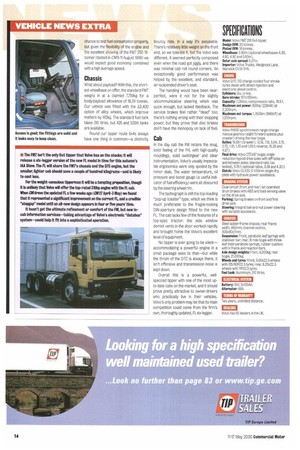Power
Page 14

Page 16

If you've noticed an error in this article please click here to report it so we can fix it.
• Volvo has introduced a new version of the FM7 with the latest D7C engine, now rated at a nominal 310hp to complement the 250 and 290hp variants. The appetite for more power seems to be as strong as ever, and nowadays there's nothing odd in specifying over 300hp for a 26tonner—and all the better if it's from a lightweight seven-litre engine.
We have driven an FM? 6x4 tipper powered by the new 310 unit (actually rated at a true 306hp) with the familiar R1400 nine-speed box. The SR1400 splitter box is an option, as is the Powertronic auto box in five or six-speed versions.
The test truck was finished off with a Rouse & Beer body, Edbro tipping gear, a Dawbarn sheeting system and the familiar B-ride bogie; in fact, the heavy-duty Tride unit is not an option on this model. We took the truck, laden to just under 26 tonnes, for a day's drive round part of our Midlands tipper route. Once it has more miles under its belt we will be undertaking a full road test.
Driveline
he D7C-310 is not a dramatically new development: it uses a conventional injection pump with electronic control, but refinements to the control systems give it more torque than ever before—a maximum of 1,350Nm at 1,200rpm, compared with the 290's torque plateau of 1,200Nm between 1,100 and 1,400rpm.
That's not just an artificial torque peak, as the 310 puts out around 150Nm more torque than the 290 throughout the economy band. This band is wide too: it stretches from from 1,200 to 1,900rpm, dropping to a minimum specific fuel consumption of 193g/kWh at around 1,450rpm.
Despite having just 400km on the clock, the Volvo was pretty free-revving, and performed strongly. The extra torque worked well with the rangechange box, and the truck sustained a 40mph cruise comfortably at 1,250rpm. The clutch was light and the gearbox gave a solid, positive shift, while the switchoperated range-change felt more decisive than a slap-across type.
We only felt the need for a splitter box once, when the gruelling Edge Hill climb exposed a gap in the ratios. It wasn't possible logo confidently from third gear to fourth as the hill flattened out, despite the generous torque backup on offer. Even so, the FM7 stormed up the hill in an impressive 2min 11sec.
Running downhill the Volvo engine was less impressive: though the standard exhaust brake is claimed to offer 105kW of retardation power, it had little effect even at 2,500rpm, perilously near the red line, Still, at least the foot-off control is sensible and the on/off switch is handily placed on the left-hand side of the wrap-around dash.
On a drive like this we didn't get the
chance to test fuel consumption properly, but given the flexibility of the engine and the excellent showing of the FM7 250 18tonner (tested in 0115-11 August 1989) we would expect good economy combined with a high average speed.
Chassis What about payload? With this, the shortest wheelbase on offer, the standard FM7 weighs in at a claimed 7,759kg for a body/payload allowance of 18.24 tonnes. Our vehicle was fitted with the £3,400 option of alloy wheels, which improve matters by 142kg. The standard fuel tank takes 310 litres, but 425 and 535Iit tanks are available.
Round our tipper route 6x4s always have one thing in common—a distinctly bouncy ride. In a way WS excusable. There's relatively little weight on the front end, so we tolerate it, but the Volvo was different. It seemed perfectly composed even when the road got jiggly, and there was minimal cab roll round corners. An exceptionally goad performance was helped by the excellent, and standard, air-suspended driver's seat.
The handling would have been nearperfect, were it not for the slightly uncommunicative steering which was quick enough, but lacked feedback. The service brakes feel rather "dead" too; there's nothing wrong with their stopping power, but they prove that disc brakes don't have the monopoly on lack of feel.
Cab In the day cab the FM retains the snug, sad feeling of the FH, with high-quality mouldings, solid switchgear and clear instrumentation. Volvo's usually impeccable ergonomics were only spoiled by the minor dials. The water temperature, oil pressure and boost gauge (a useful indicator of fuel efficiency) were all obscured by the steering wheel rim.
The tachograph is still the top-loading "pop-up toaster" type, which we think is much preferable to the fragile-looking DIN-aperture design fitted to the new FL. The cab lacks few of the features of a top-spec tractor: the side window demist vents in the door worked rapidly and brought home the Volvo's excellent level of equipment.
No tipper is ever going to be silent— accommodating a powerful engine in a small package sees to that—but while the thrum of the D7C is always there, it isn't offensive and transmission noise is kept down.
Overall this is a powerful, wellspecced tipper with one of the most upto-date cabs on the market, and it should prove pretty attractive to owner-drivers who practically live in their vehicles. Volvo's only problem may be that its main competition could come from the firm's own, thoroughly updated, FL six-legger.




































































































